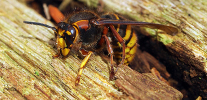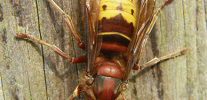
The hornet uterus is the center and foundation of the whole huge family. It is she who gives rise to a new nest: it lifts it up independently and feeds its first future helpers. But even after their appearance, the significance of the uterus does not diminish at all, because it will always be the only source of new individuals in the family.
The hornet uterus noticeably stands out among the whole family for its size, but this is only an outward difference. The main feature of this unique breeding female in the family is its life cycle, in which there is a lot of interesting and surprising.
On a note
All working individuals in hornets nestas well as in other social insects, they are females.

As a rule, in every family of hornets there is only one uterus. It is around her that all the fast, but precisely organized life of the nest revolves. Only in some species (and that - occasionally) polygyny can be observed (from the English. "Poly" - a lot, "queen" - the queen) - a phenomenon when several females lay eggs at once in a nest.
In the overwhelming majority of cases, working individuals of hornets are unable to reproduce, but in some species, under the influence of environmental conditions, certain hormonal changes may occur. As a result of these failures, individual females have the opportunity to lay unfertilized eggs, from which similar working individuals will be removed. It is worth noting that, despite its gender identity and ability to reproduce, such a female hornet cannot be called a uterus.
Appearance, features and photos of the hornet uterus
The hornet's uterus is the largest individual in the family. For example, the main female European hornet reaches a length of 3 cm, while the indicators of a working individual are much more modest - only 2 cm. However, even these figures are far from the limit: for example, with tropical hornets the uterus can reach a length of 5, 5 cm
In the photo - the main female hornet in the nest:

But even in spite of quite serious dimensions, the uterus can easily be confused with an ordinary working individual: it becomes possible if the main female is in sight, alone, away from the nest and simply cannot be compared with when she is feeding or collecting building material.
As a rule, the queen of hornets flies at the beginning of spring, when she is forced to gather food for her offspring herself, or at the end of autumn, after mating swarming.
On flowers, trees and in case of accidental exposure to living quarters, the hornet's uterus looks like an ordinary large wasp. In the photo below, it is clearly seen that it has a typical wasp waist, characteristic black dressings on the abdomen with a brown base and a brown spot in the shape of a horseshoe on the back:

Thus, in most cases, the hornet's uterus has the same color as all other inhabitants of the nest. That is why, despite the large size, in conditions of large concentrations of working individuals, finding their queen will not be easy.
The photo - the hornet uterus in the center of the family:


It is interesting
The original principle of the visual camouflage of insects is based on a combination of contrasting colors in coloring. When a predator wants to catch one individual from a large group, the chaotic movement of hundreds of striped bodies creates disorderly ripples in his eyes, among which it is difficult to single out a specific prey. An excellent example of this principle are zebras, which is why they have a characteristic striped dress.Hornet coloring got from peace-loving ancestors, bees, who were forced to defend themselves against predators by all means.

It is worth noting that the hornet's womb resembles its family members not only in coloring - it is also “poisonous” and stings with the same force as a working individual.
The beginning of the life of the uterus
The future founder of the new family of hornets is born in late August or early September. A month before this, her mother, the old queen, begins to lay fertilized eggs, from which fertile females emerge. At the same time, the old queen of hornets lays unfertilized eggs, from which males hatch.
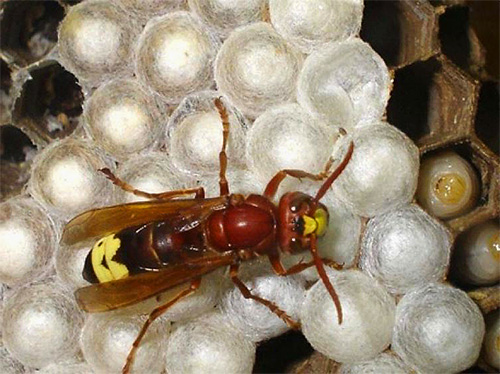
By the time of the mating period, the family of hornets is already very large: the number of working individuals in it reaches several dozen, or even hundreds. And the nest itself at this stage grows to an impressive size. For example, the home of an ordinary hornet can reach a length of 70-80 cm and weigh up to 10 kg!

All the larvae (including the young uterus) are fed exclusively meat food - other insects. However, even after the emergence of the pupae, the working individuals can feed the female followers for some time.

By the time of emergence of females capable of breeding, the old uterus is already depleting its potential and practically stops laying eggs. Therefore, it is often the case that the working hornets expel her from the nest or even kill.
In the photo - the old hornet uterus:

When young females and males in the nest become too much, they fly out of the mother's house, swarm and mate. The males then die within a few days, and the females may hunt for some time or look for sweet fruit for food. However, with the cold weather approaching, they still find suitable shelters for wintering: under the stones, in the crevices of the crust, hollows, and also in the nests in which all the working individuals have already died out.
It is interesting
If the female chose an already used nest as a shelter for wintering, then it is likely that she will not live to the end of winter. Usually in old nests before the onset of cold weather live working hornetswho are not allowed back young people who have already flown out. But there is another reason for the low survival rate: sometimes in the nest, working individuals die out due to tick-borne and bacterial infections that do not spare the young females hiding here.
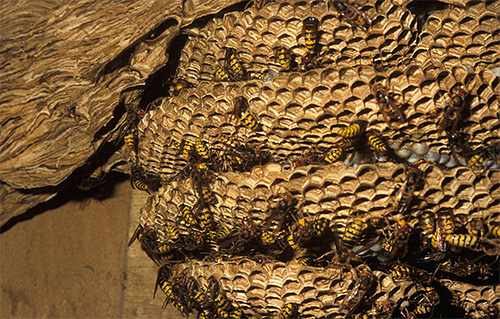
The wintering stage is absent in tropical hornets: these females immediately after mating establish new nests. But sometimes they return to their native family, initiating the expulsion of the old uterus, and begin to rule the already developed nest.
Wintering - the most difficult stage
During wintering, all the processes in the body of a young female slow down, so she is the most economical in spending the energy reserves accumulated in autumn. However, a significant number of females perish at this stage from frosts and predators - insectivorous mammals and birds.
Those uterus of the hornet, which hibernate on trees under large layers of bark, are the most protected: birds cannot always penetrate under them, and there are not many other insect hunters at this time.
In the photo - the hornet's uterus during wintering in the gap between the logs:

Founding a new family
In the spring, with the onset of heat, the young female awakens from a winter stupor and actively eats for several days to recuperate.
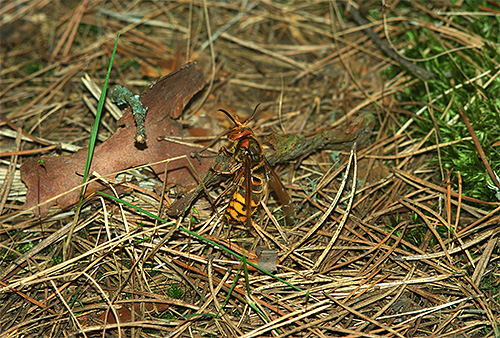
The basis of its diet during this period is made up of other insects, and sometimes berries and fruits thawing from under the snow.
At the same time, the future queen is looking for a convenient place to place a nest: it can be just a strong branch or a hollow, a hole in a rock, or a hole in a sandy slope.The uterus collects the soft young bark from the branches of trees, chews it and builds the first honeycomb, in which it immediately lays its eggs.
In parallel, the young uterus continues to create a new nest of hornets, building on the primary structure. The home of insects, thanks only to the strength of one of the founding womb, can sometimes reach half the size of a soccer ball.

When the first larvae hatch from eggs, the uterus itself catches insects for them and feeds its future helpers. With the appearance of the first working individuals, the queen of hornets practically ceases to fly, all its activity is reduced only to laying eggs. Insect workers take on all the responsibilities for obtaining food for the larvae and the uterus, care for them, as well as the construction of new honeycombs.

It is interesting
Among all 23 species of hornet there is one, radically different from their relatives - black hornet. His females show the so-called nesting parasitism: they do not build nests and do not feed the first larvae. All spring, females simply feed carelessly, and at the beginning of summer they find a family of ordinary hornets, penetrate their nest, kill the uterus and, masking themselves with pheromones, impersonate themselves.Of course, such a "trick" is very dangerous, because workers can kill an alien before she even gets to their womb. However, such a seizure of power often takes place nevertheless successfully, and the working individuals look after the new queen as diligently as they tended the previous one. Of course, new - black - hornets will emerge from the eggs laid by her, which will gradually replace the old owners of the nest.
Queen of the Hornets
In the nest, the womb of the hornets is indeed the real queen. The whole family lives around it: it is fed, the eggs laid by it are picked up and neatly spread by honeycombs, it is protected to the last in case of an attack on the hive. The uterus, in turn, provides a constant increase in the population in the nest, laying several dozen eggs every day.

The connection of the uterus with working hornets occurs through chemical odor signals. If something happens to her, after a few seconds all the hornets that are in the nest know about it.
As mentioned above, at the top of the family’s power (for European hornets around August), the uterus begins to lay fertilized eggs, from which females and males can reproduce due to hormonal mechanisms.This stage is of great importance for each type of hornets, but for any single uterus it means the approach of its death ...
Old age and sunset horny empire
Having started laying eggs, from which males and females capable of breeding will be hatching, the uterus practically loses its egg-bearing potential. For a few more weeks, she will continue to provide the nest with offspring, but the number of eggs will inexorably decrease. And after a short time, the queen will completely stop producing eggs.

By this time, the vital resources of the uterus are depleted: it diminishes, barely creeps, loses some of the hairs on the body. Working individuals practically cease to feed her, and they themselves become very few.
After the departure of young insects from the nest, ticks and other parasites of hornets often begin to multiply here, from which the uterus often dies. But even if there is no infection in the hive, when the frost comes, all the remaining working individuals and the old queen will die.
Thus, the life of almost every hornet's uterus consists of several main stages:
- out of the larva;
- pairing;
- wintering (tropical species of this stage do not have due to climatic conditions);
- the construction of the first hundred cells of the future nest (with the exception of the black hornet) and the laying of the first larvae;
- providing the family with offspring (including - capable of breeding females and males);
- death.

However, not everything is so sad: somewhere around the nest, young, strong and fertilized females are already finding themselves winter apartments, who will start the cycle anew in the spring, continuing with their incessant work to write the history of the species.
Interesting video: how hornets care for their larvae in the nest
A few hornets against a beehive of many thousands: who wins?


